Strategy and Change management- Natwest Bank
VerifiedAdded on 2023/06/15
|13
|3818
|286
AI Summary
This report discusses the strategy and change management of Natwest Bank. It covers the market size, Covid-19 impact, and fin tech use. The report also analyzes the McKinsey strategy change model and provides recommendations for the most suitable strategy. The PESTEL analysis is also discussed along with the drivers of change opportunities and threats.
Contribute Materials
Your contribution can guide someone’s learning journey. Share your
documents today.
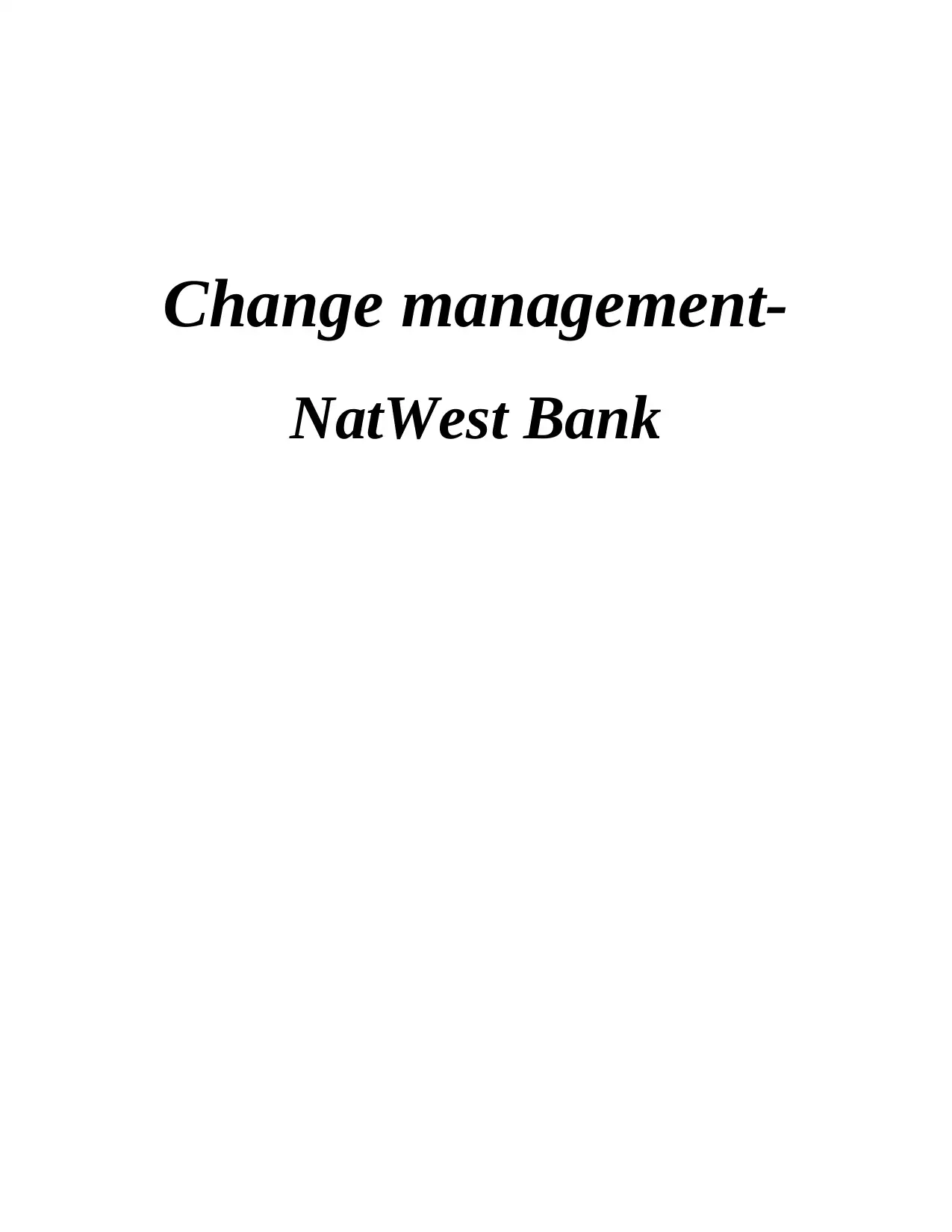
Change management-
NatWest Bank
NatWest Bank
Secure Best Marks with AI Grader
Need help grading? Try our AI Grader for instant feedback on your assignments.
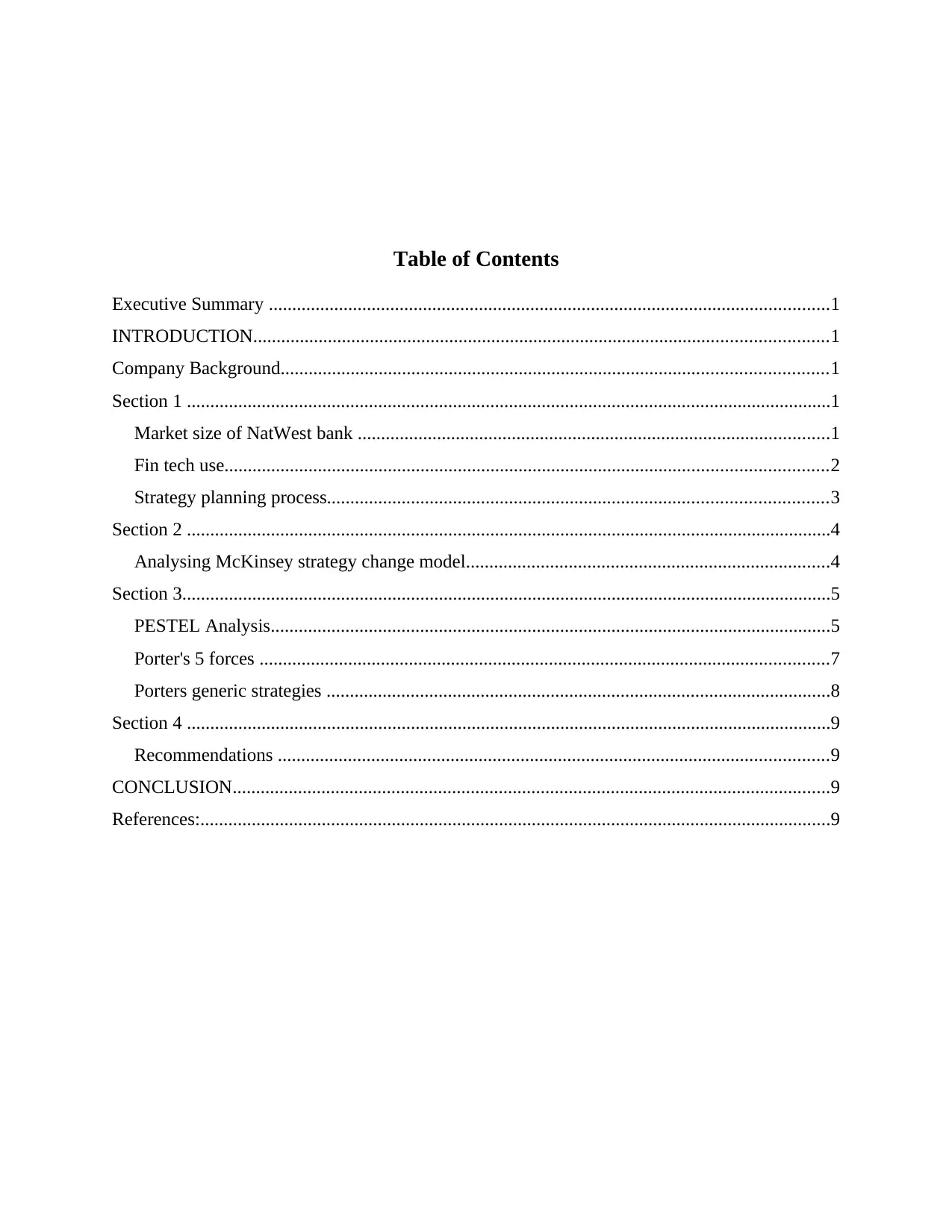
Table of Contents
Executive Summary ........................................................................................................................1
INTRODUCTION...........................................................................................................................1
Company Background.....................................................................................................................1
Section 1 ..........................................................................................................................................1
Market size of NatWest bank .....................................................................................................1
Fin tech use.................................................................................................................................2
Strategy planning process...........................................................................................................3
Section 2 ..........................................................................................................................................4
Analysing McKinsey strategy change model..............................................................................4
Section 3...........................................................................................................................................5
PESTEL Analysis........................................................................................................................5
Porter's 5 forces ..........................................................................................................................7
Porters generic strategies ............................................................................................................8
Section 4 ..........................................................................................................................................9
Recommendations ......................................................................................................................9
CONCLUSION................................................................................................................................9
References:.......................................................................................................................................9
Executive Summary ........................................................................................................................1
INTRODUCTION...........................................................................................................................1
Company Background.....................................................................................................................1
Section 1 ..........................................................................................................................................1
Market size of NatWest bank .....................................................................................................1
Fin tech use.................................................................................................................................2
Strategy planning process...........................................................................................................3
Section 2 ..........................................................................................................................................4
Analysing McKinsey strategy change model..............................................................................4
Section 3...........................................................................................................................................5
PESTEL Analysis........................................................................................................................5
Porter's 5 forces ..........................................................................................................................7
Porters generic strategies ............................................................................................................8
Section 4 ..........................................................................................................................................9
Recommendations ......................................................................................................................9
CONCLUSION................................................................................................................................9
References:.......................................................................................................................................9
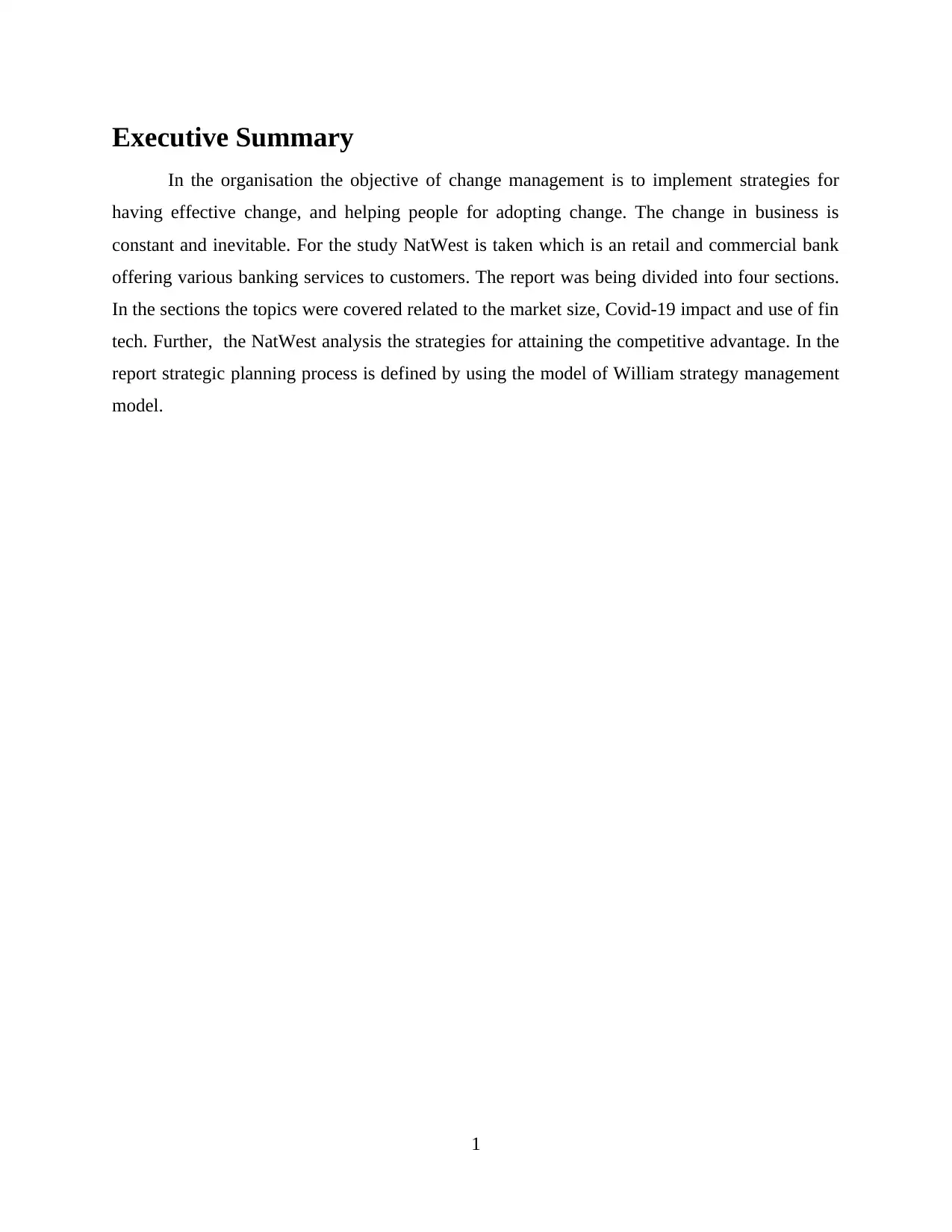
Executive Summary
In the organisation the objective of change management is to implement strategies for
having effective change, and helping people for adopting change. The change in business is
constant and inevitable. For the study NatWest is taken which is an retail and commercial bank
offering various banking services to customers. The report was being divided into four sections.
In the sections the topics were covered related to the market size, Covid-19 impact and use of fin
tech. Further, the NatWest analysis the strategies for attaining the competitive advantage. In the
report strategic planning process is defined by using the model of William strategy management
model.
1
In the organisation the objective of change management is to implement strategies for
having effective change, and helping people for adopting change. The change in business is
constant and inevitable. For the study NatWest is taken which is an retail and commercial bank
offering various banking services to customers. The report was being divided into four sections.
In the sections the topics were covered related to the market size, Covid-19 impact and use of fin
tech. Further, the NatWest analysis the strategies for attaining the competitive advantage. In the
report strategic planning process is defined by using the model of William strategy management
model.
1
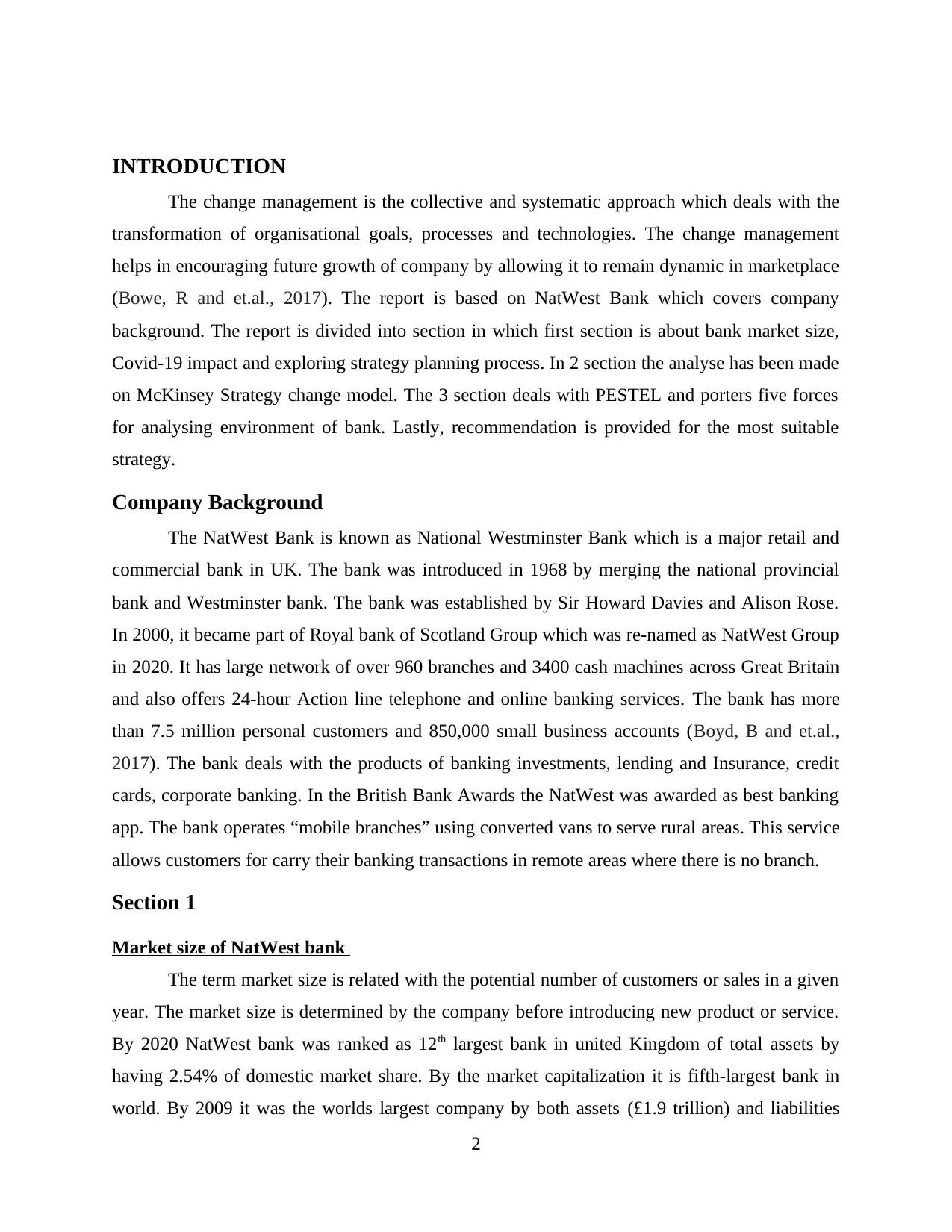
INTRODUCTION
The change management is the collective and systematic approach which deals with the
transformation of organisational goals, processes and technologies. The change management
helps in encouraging future growth of company by allowing it to remain dynamic in marketplace
(Bowe, R and et.al., 2017). The report is based on NatWest Bank which covers company
background. The report is divided into section in which first section is about bank market size,
Covid-19 impact and exploring strategy planning process. In 2 section the analyse has been made
on McKinsey Strategy change model. The 3 section deals with PESTEL and porters five forces
for analysing environment of bank. Lastly, recommendation is provided for the most suitable
strategy.
Company Background
The NatWest Bank is known as National Westminster Bank which is a major retail and
commercial bank in UK. The bank was introduced in 1968 by merging the national provincial
bank and Westminster bank. The bank was established by Sir Howard Davies and Alison Rose.
In 2000, it became part of Royal bank of Scotland Group which was re-named as NatWest Group
in 2020. It has large network of over 960 branches and 3400 cash machines across Great Britain
and also offers 24-hour Action line telephone and online banking services. The bank has more
than 7.5 million personal customers and 850,000 small business accounts (Boyd, B and et.al.,
2017). The bank deals with the products of banking investments, lending and Insurance, credit
cards, corporate banking. In the British Bank Awards the NatWest was awarded as best banking
app. The bank operates “mobile branches” using converted vans to serve rural areas. This service
allows customers for carry their banking transactions in remote areas where there is no branch.
Section 1
Market size of NatWest bank
The term market size is related with the potential number of customers or sales in a given
year. The market size is determined by the company before introducing new product or service.
By 2020 NatWest bank was ranked as 12th largest bank in united Kingdom of total assets by
having 2.54% of domestic market share. By the market capitalization it is fifth-largest bank in
world. By 2009 it was the worlds largest company by both assets (£1.9 trillion) and liabilities
2
The change management is the collective and systematic approach which deals with the
transformation of organisational goals, processes and technologies. The change management
helps in encouraging future growth of company by allowing it to remain dynamic in marketplace
(Bowe, R and et.al., 2017). The report is based on NatWest Bank which covers company
background. The report is divided into section in which first section is about bank market size,
Covid-19 impact and exploring strategy planning process. In 2 section the analyse has been made
on McKinsey Strategy change model. The 3 section deals with PESTEL and porters five forces
for analysing environment of bank. Lastly, recommendation is provided for the most suitable
strategy.
Company Background
The NatWest Bank is known as National Westminster Bank which is a major retail and
commercial bank in UK. The bank was introduced in 1968 by merging the national provincial
bank and Westminster bank. The bank was established by Sir Howard Davies and Alison Rose.
In 2000, it became part of Royal bank of Scotland Group which was re-named as NatWest Group
in 2020. It has large network of over 960 branches and 3400 cash machines across Great Britain
and also offers 24-hour Action line telephone and online banking services. The bank has more
than 7.5 million personal customers and 850,000 small business accounts (Boyd, B and et.al.,
2017). The bank deals with the products of banking investments, lending and Insurance, credit
cards, corporate banking. In the British Bank Awards the NatWest was awarded as best banking
app. The bank operates “mobile branches” using converted vans to serve rural areas. This service
allows customers for carry their banking transactions in remote areas where there is no branch.
Section 1
Market size of NatWest bank
The term market size is related with the potential number of customers or sales in a given
year. The market size is determined by the company before introducing new product or service.
By 2020 NatWest bank was ranked as 12th largest bank in united Kingdom of total assets by
having 2.54% of domestic market share. By the market capitalization it is fifth-largest bank in
world. By 2009 it was the worlds largest company by both assets (£1.9 trillion) and liabilities
2
Secure Best Marks with AI Grader
Need help grading? Try our AI Grader for instant feedback on your assignments.
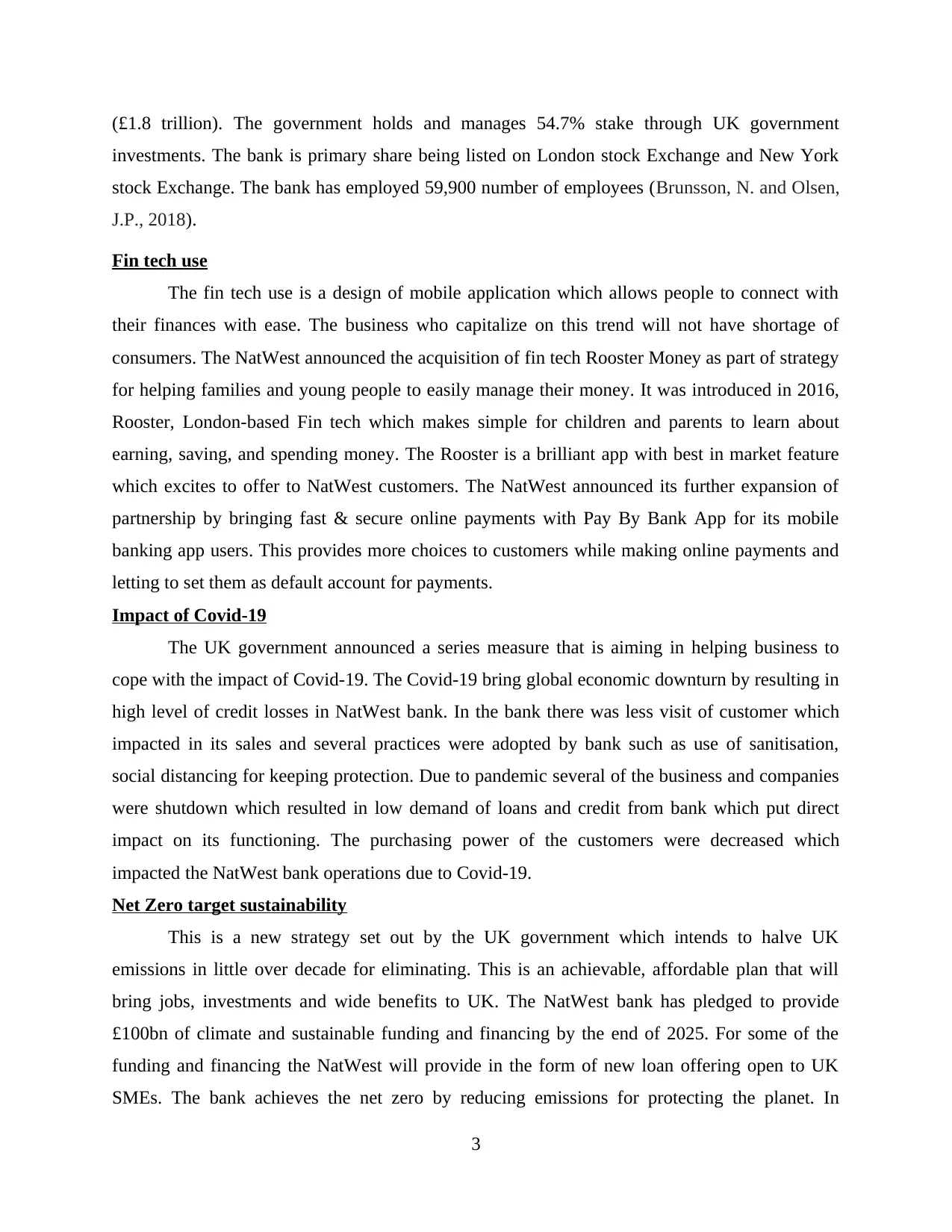
(£1.8 trillion). The government holds and manages 54.7% stake through UK government
investments. The bank is primary share being listed on London stock Exchange and New York
stock Exchange. The bank has employed 59,900 number of employees (Brunsson, N. and Olsen,
J.P., 2018).
Fin tech use
The fin tech use is a design of mobile application which allows people to connect with
their finances with ease. The business who capitalize on this trend will not have shortage of
consumers. The NatWest announced the acquisition of fin tech Rooster Money as part of strategy
for helping families and young people to easily manage their money. It was introduced in 2016,
Rooster, London-based Fin tech which makes simple for children and parents to learn about
earning, saving, and spending money. The Rooster is a brilliant app with best in market feature
which excites to offer to NatWest customers. The NatWest announced its further expansion of
partnership by bringing fast & secure online payments with Pay By Bank App for its mobile
banking app users. This provides more choices to customers while making online payments and
letting to set them as default account for payments.
Impact of Covid-19
The UK government announced a series measure that is aiming in helping business to
cope with the impact of Covid-19. The Covid-19 bring global economic downturn by resulting in
high level of credit losses in NatWest bank. In the bank there was less visit of customer which
impacted in its sales and several practices were adopted by bank such as use of sanitisation,
social distancing for keeping protection. Due to pandemic several of the business and companies
were shutdown which resulted in low demand of loans and credit from bank which put direct
impact on its functioning. The purchasing power of the customers were decreased which
impacted the NatWest bank operations due to Covid-19.
Net Zero target sustainability
This is a new strategy set out by the UK government which intends to halve UK
emissions in little over decade for eliminating. This is an achievable, affordable plan that will
bring jobs, investments and wide benefits to UK. The NatWest bank has pledged to provide
£100bn of climate and sustainable funding and financing by the end of 2025. For some of the
funding and financing the NatWest will provide in the form of new loan offering open to UK
SMEs. The bank achieves the net zero by reducing emissions for protecting the planet. In
3
investments. The bank is primary share being listed on London stock Exchange and New York
stock Exchange. The bank has employed 59,900 number of employees (Brunsson, N. and Olsen,
J.P., 2018).
Fin tech use
The fin tech use is a design of mobile application which allows people to connect with
their finances with ease. The business who capitalize on this trend will not have shortage of
consumers. The NatWest announced the acquisition of fin tech Rooster Money as part of strategy
for helping families and young people to easily manage their money. It was introduced in 2016,
Rooster, London-based Fin tech which makes simple for children and parents to learn about
earning, saving, and spending money. The Rooster is a brilliant app with best in market feature
which excites to offer to NatWest customers. The NatWest announced its further expansion of
partnership by bringing fast & secure online payments with Pay By Bank App for its mobile
banking app users. This provides more choices to customers while making online payments and
letting to set them as default account for payments.
Impact of Covid-19
The UK government announced a series measure that is aiming in helping business to
cope with the impact of Covid-19. The Covid-19 bring global economic downturn by resulting in
high level of credit losses in NatWest bank. In the bank there was less visit of customer which
impacted in its sales and several practices were adopted by bank such as use of sanitisation,
social distancing for keeping protection. Due to pandemic several of the business and companies
were shutdown which resulted in low demand of loans and credit from bank which put direct
impact on its functioning. The purchasing power of the customers were decreased which
impacted the NatWest bank operations due to Covid-19.
Net Zero target sustainability
This is a new strategy set out by the UK government which intends to halve UK
emissions in little over decade for eliminating. This is an achievable, affordable plan that will
bring jobs, investments and wide benefits to UK. The NatWest bank has pledged to provide
£100bn of climate and sustainable funding and financing by the end of 2025. For some of the
funding and financing the NatWest will provide in the form of new loan offering open to UK
SMEs. The bank achieves the net zero by reducing emissions for protecting the planet. In
3
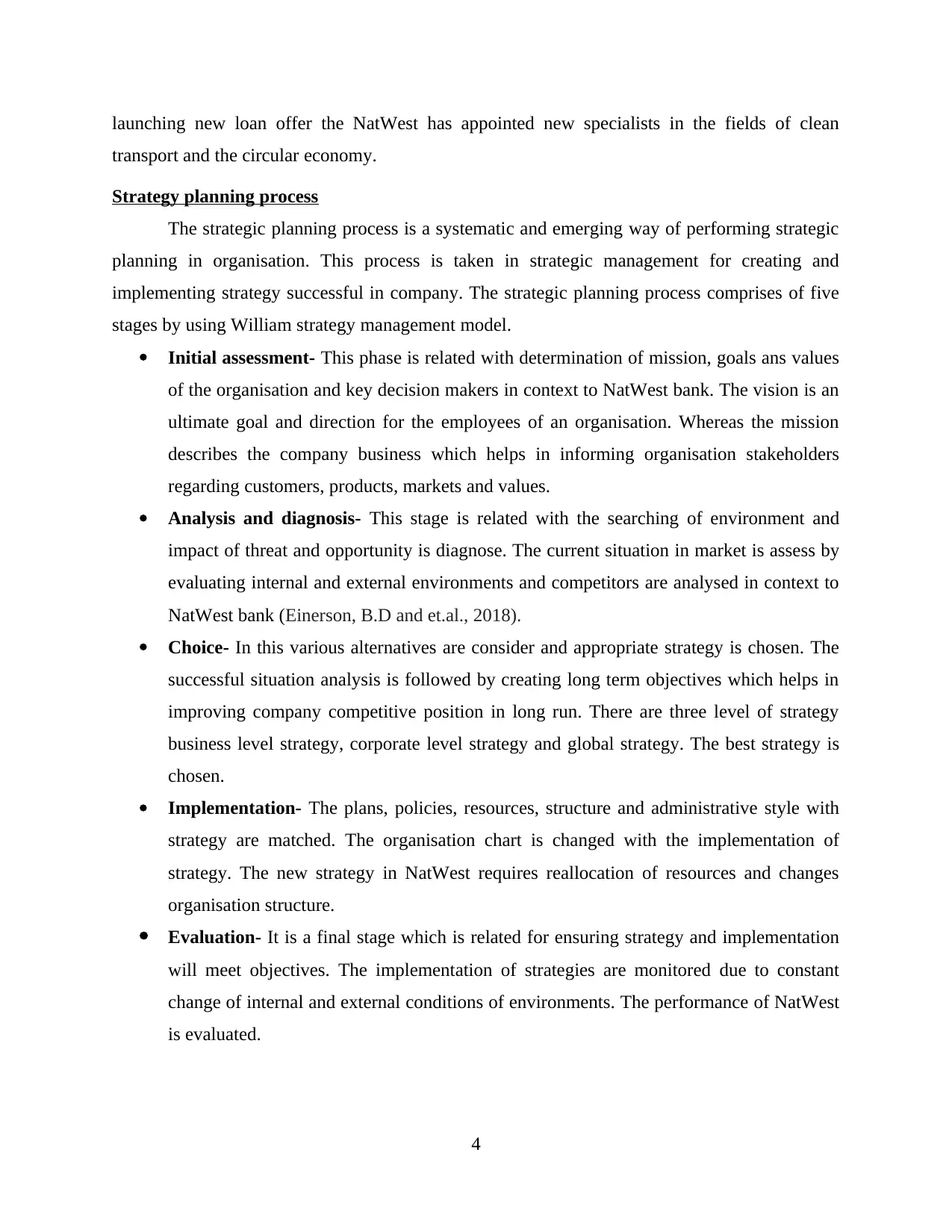
launching new loan offer the NatWest has appointed new specialists in the fields of clean
transport and the circular economy.
Strategy planning process
The strategic planning process is a systematic and emerging way of performing strategic
planning in organisation. This process is taken in strategic management for creating and
implementing strategy successful in company. The strategic planning process comprises of five
stages by using William strategy management model.
Initial assessment- This phase is related with determination of mission, goals ans values
of the organisation and key decision makers in context to NatWest bank. The vision is an
ultimate goal and direction for the employees of an organisation. Whereas the mission
describes the company business which helps in informing organisation stakeholders
regarding customers, products, markets and values.
Analysis and diagnosis- This stage is related with the searching of environment and
impact of threat and opportunity is diagnose. The current situation in market is assess by
evaluating internal and external environments and competitors are analysed in context to
NatWest bank (Einerson, B.D and et.al., 2018).
Choice- In this various alternatives are consider and appropriate strategy is chosen. The
successful situation analysis is followed by creating long term objectives which helps in
improving company competitive position in long run. There are three level of strategy
business level strategy, corporate level strategy and global strategy. The best strategy is
chosen.
Implementation- The plans, policies, resources, structure and administrative style with
strategy are matched. The organisation chart is changed with the implementation of
strategy. The new strategy in NatWest requires reallocation of resources and changes
organisation structure.
Evaluation- It is a final stage which is related for ensuring strategy and implementation
will meet objectives. The implementation of strategies are monitored due to constant
change of internal and external conditions of environments. The performance of NatWest
is evaluated.
4
transport and the circular economy.
Strategy planning process
The strategic planning process is a systematic and emerging way of performing strategic
planning in organisation. This process is taken in strategic management for creating and
implementing strategy successful in company. The strategic planning process comprises of five
stages by using William strategy management model.
Initial assessment- This phase is related with determination of mission, goals ans values
of the organisation and key decision makers in context to NatWest bank. The vision is an
ultimate goal and direction for the employees of an organisation. Whereas the mission
describes the company business which helps in informing organisation stakeholders
regarding customers, products, markets and values.
Analysis and diagnosis- This stage is related with the searching of environment and
impact of threat and opportunity is diagnose. The current situation in market is assess by
evaluating internal and external environments and competitors are analysed in context to
NatWest bank (Einerson, B.D and et.al., 2018).
Choice- In this various alternatives are consider and appropriate strategy is chosen. The
successful situation analysis is followed by creating long term objectives which helps in
improving company competitive position in long run. There are three level of strategy
business level strategy, corporate level strategy and global strategy. The best strategy is
chosen.
Implementation- The plans, policies, resources, structure and administrative style with
strategy are matched. The organisation chart is changed with the implementation of
strategy. The new strategy in NatWest requires reallocation of resources and changes
organisation structure.
Evaluation- It is a final stage which is related for ensuring strategy and implementation
will meet objectives. The implementation of strategies are monitored due to constant
change of internal and external conditions of environments. The performance of NatWest
is evaluated.
4
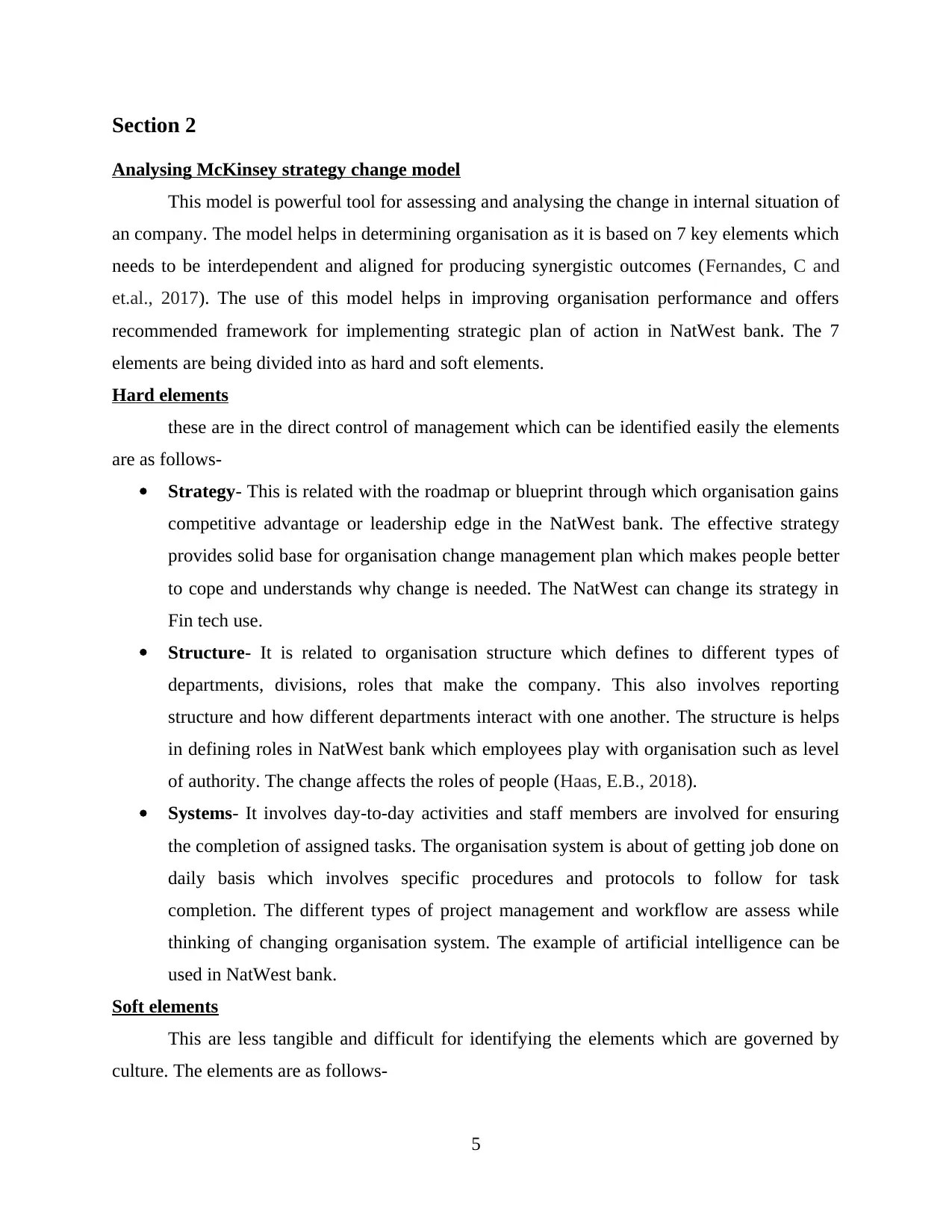
Section 2
Analysing McKinsey strategy change model
This model is powerful tool for assessing and analysing the change in internal situation of
an company. The model helps in determining organisation as it is based on 7 key elements which
needs to be interdependent and aligned for producing synergistic outcomes (Fernandes, C and
et.al., 2017). The use of this model helps in improving organisation performance and offers
recommended framework for implementing strategic plan of action in NatWest bank. The 7
elements are being divided into as hard and soft elements.
Hard elements
these are in the direct control of management which can be identified easily the elements
are as follows-
Strategy- This is related with the roadmap or blueprint through which organisation gains
competitive advantage or leadership edge in the NatWest bank. The effective strategy
provides solid base for organisation change management plan which makes people better
to cope and understands why change is needed. The NatWest can change its strategy in
Fin tech use.
Structure- It is related to organisation structure which defines to different types of
departments, divisions, roles that make the company. This also involves reporting
structure and how different departments interact with one another. The structure is helps
in defining roles in NatWest bank which employees play with organisation such as level
of authority. The change affects the roles of people (Haas, E.B., 2018).
Systems- It involves day-to-day activities and staff members are involved for ensuring
the completion of assigned tasks. The organisation system is about of getting job done on
daily basis which involves specific procedures and protocols to follow for task
completion. The different types of project management and workflow are assess while
thinking of changing organisation system. The example of artificial intelligence can be
used in NatWest bank.
Soft elements
This are less tangible and difficult for identifying the elements which are governed by
culture. The elements are as follows-
5
Analysing McKinsey strategy change model
This model is powerful tool for assessing and analysing the change in internal situation of
an company. The model helps in determining organisation as it is based on 7 key elements which
needs to be interdependent and aligned for producing synergistic outcomes (Fernandes, C and
et.al., 2017). The use of this model helps in improving organisation performance and offers
recommended framework for implementing strategic plan of action in NatWest bank. The 7
elements are being divided into as hard and soft elements.
Hard elements
these are in the direct control of management which can be identified easily the elements
are as follows-
Strategy- This is related with the roadmap or blueprint through which organisation gains
competitive advantage or leadership edge in the NatWest bank. The effective strategy
provides solid base for organisation change management plan which makes people better
to cope and understands why change is needed. The NatWest can change its strategy in
Fin tech use.
Structure- It is related to organisation structure which defines to different types of
departments, divisions, roles that make the company. This also involves reporting
structure and how different departments interact with one another. The structure is helps
in defining roles in NatWest bank which employees play with organisation such as level
of authority. The change affects the roles of people (Haas, E.B., 2018).
Systems- It involves day-to-day activities and staff members are involved for ensuring
the completion of assigned tasks. The organisation system is about of getting job done on
daily basis which involves specific procedures and protocols to follow for task
completion. The different types of project management and workflow are assess while
thinking of changing organisation system. The example of artificial intelligence can be
used in NatWest bank.
Soft elements
This are less tangible and difficult for identifying the elements which are governed by
culture. The elements are as follows-
5
Paraphrase This Document
Need a fresh take? Get an instant paraphrase of this document with our AI Paraphraser
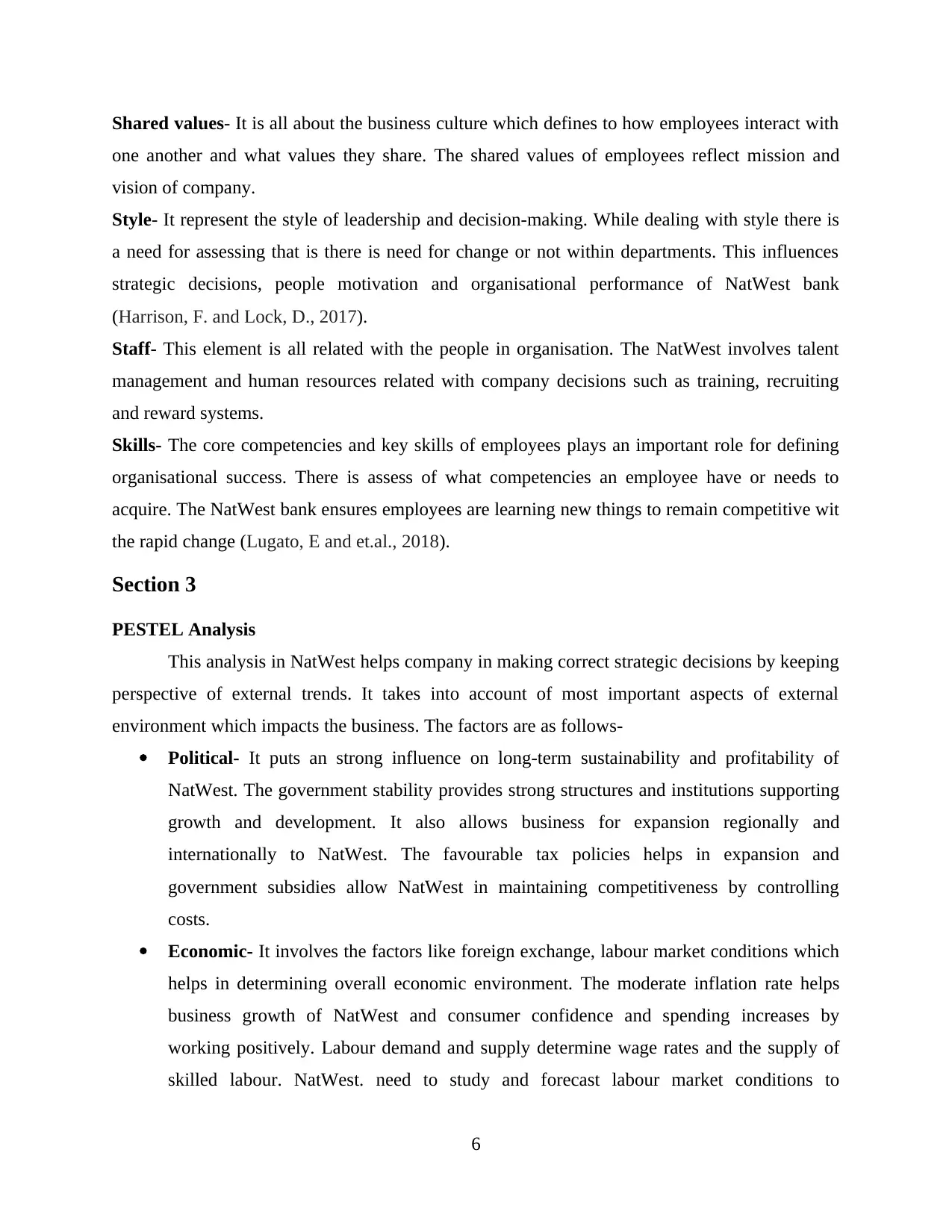
Shared values- It is all about the business culture which defines to how employees interact with
one another and what values they share. The shared values of employees reflect mission and
vision of company.
Style- It represent the style of leadership and decision-making. While dealing with style there is
a need for assessing that is there is need for change or not within departments. This influences
strategic decisions, people motivation and organisational performance of NatWest bank
(Harrison, F. and Lock, D., 2017).
Staff- This element is all related with the people in organisation. The NatWest involves talent
management and human resources related with company decisions such as training, recruiting
and reward systems.
Skills- The core competencies and key skills of employees plays an important role for defining
organisational success. There is assess of what competencies an employee have or needs to
acquire. The NatWest bank ensures employees are learning new things to remain competitive wit
the rapid change (Lugato, E and et.al., 2018).
Section 3
PESTEL Analysis
This analysis in NatWest helps company in making correct strategic decisions by keeping
perspective of external trends. It takes into account of most important aspects of external
environment which impacts the business. The factors are as follows-
Political- It puts an strong influence on long-term sustainability and profitability of
NatWest. The government stability provides strong structures and institutions supporting
growth and development. It also allows business for expansion regionally and
internationally to NatWest. The favourable tax policies helps in expansion and
government subsidies allow NatWest in maintaining competitiveness by controlling
costs.
Economic- It involves the factors like foreign exchange, labour market conditions which
helps in determining overall economic environment. The moderate inflation rate helps
business growth of NatWest and consumer confidence and spending increases by
working positively. Labour demand and supply determine wage rates and the supply of
skilled labour. NatWest. need to study and forecast labour market conditions to
6
one another and what values they share. The shared values of employees reflect mission and
vision of company.
Style- It represent the style of leadership and decision-making. While dealing with style there is
a need for assessing that is there is need for change or not within departments. This influences
strategic decisions, people motivation and organisational performance of NatWest bank
(Harrison, F. and Lock, D., 2017).
Staff- This element is all related with the people in organisation. The NatWest involves talent
management and human resources related with company decisions such as training, recruiting
and reward systems.
Skills- The core competencies and key skills of employees plays an important role for defining
organisational success. There is assess of what competencies an employee have or needs to
acquire. The NatWest bank ensures employees are learning new things to remain competitive wit
the rapid change (Lugato, E and et.al., 2018).
Section 3
PESTEL Analysis
This analysis in NatWest helps company in making correct strategic decisions by keeping
perspective of external trends. It takes into account of most important aspects of external
environment which impacts the business. The factors are as follows-
Political- It puts an strong influence on long-term sustainability and profitability of
NatWest. The government stability provides strong structures and institutions supporting
growth and development. It also allows business for expansion regionally and
internationally to NatWest. The favourable tax policies helps in expansion and
government subsidies allow NatWest in maintaining competitiveness by controlling
costs.
Economic- It involves the factors like foreign exchange, labour market conditions which
helps in determining overall economic environment. The moderate inflation rate helps
business growth of NatWest and consumer confidence and spending increases by
working positively. Labour demand and supply determine wage rates and the supply of
skilled labour. NatWest. need to study and forecast labour market conditions to
6
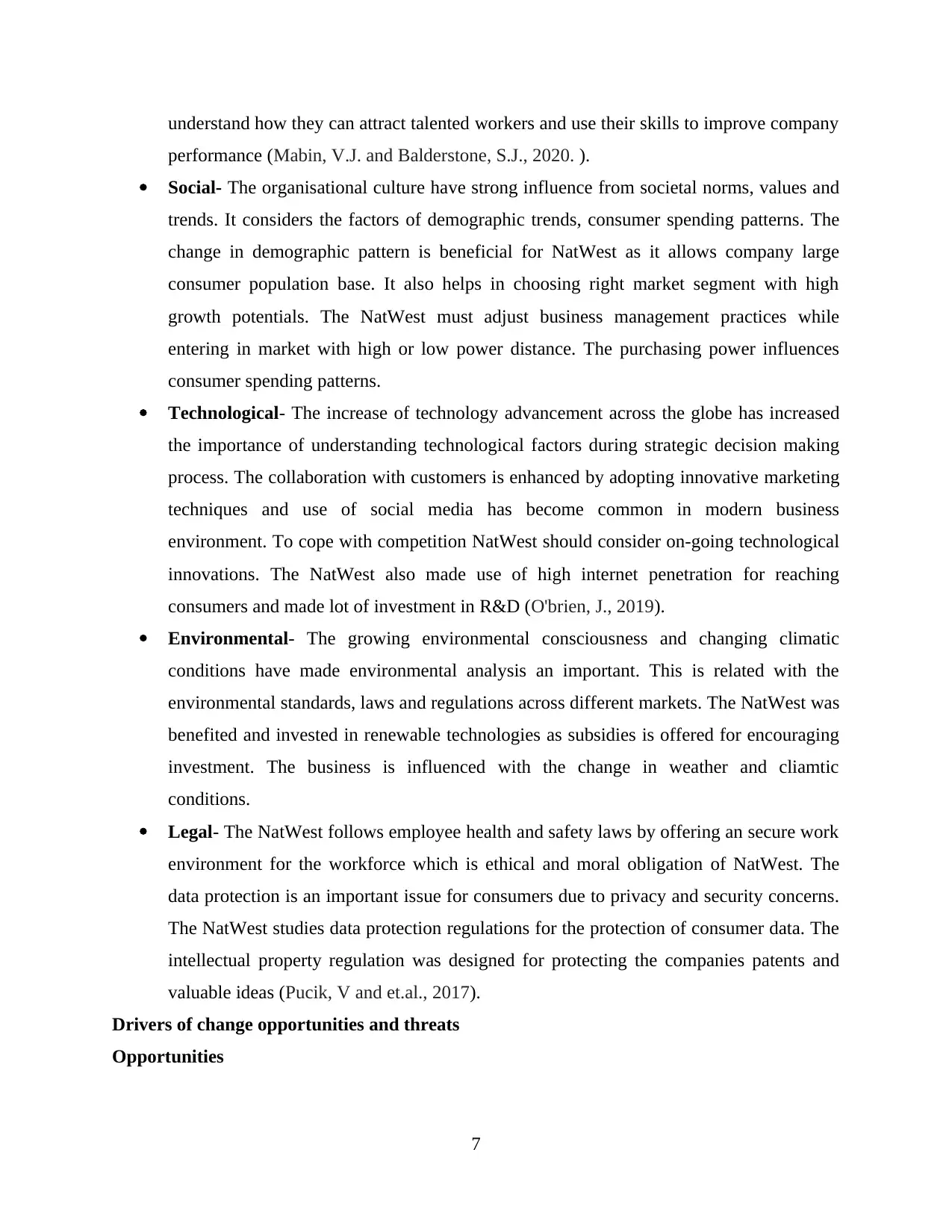
understand how they can attract talented workers and use their skills to improve company
performance (Mabin, V.J. and Balderstone, S.J., 2020. ).
Social- The organisational culture have strong influence from societal norms, values and
trends. It considers the factors of demographic trends, consumer spending patterns. The
change in demographic pattern is beneficial for NatWest as it allows company large
consumer population base. It also helps in choosing right market segment with high
growth potentials. The NatWest must adjust business management practices while
entering in market with high or low power distance. The purchasing power influences
consumer spending patterns.
Technological- The increase of technology advancement across the globe has increased
the importance of understanding technological factors during strategic decision making
process. The collaboration with customers is enhanced by adopting innovative marketing
techniques and use of social media has become common in modern business
environment. To cope with competition NatWest should consider on-going technological
innovations. The NatWest also made use of high internet penetration for reaching
consumers and made lot of investment in R&D (O'brien, J., 2019).
Environmental- The growing environmental consciousness and changing climatic
conditions have made environmental analysis an important. This is related with the
environmental standards, laws and regulations across different markets. The NatWest was
benefited and invested in renewable technologies as subsidies is offered for encouraging
investment. The business is influenced with the change in weather and cliamtic
conditions.
Legal- The NatWest follows employee health and safety laws by offering an secure work
environment for the workforce which is ethical and moral obligation of NatWest. The
data protection is an important issue for consumers due to privacy and security concerns.
The NatWest studies data protection regulations for the protection of consumer data. The
intellectual property regulation was designed for protecting the companies patents and
valuable ideas (Pucik, V and et.al., 2017).
Drivers of change opportunities and threats
Opportunities
7
performance (Mabin, V.J. and Balderstone, S.J., 2020. ).
Social- The organisational culture have strong influence from societal norms, values and
trends. It considers the factors of demographic trends, consumer spending patterns. The
change in demographic pattern is beneficial for NatWest as it allows company large
consumer population base. It also helps in choosing right market segment with high
growth potentials. The NatWest must adjust business management practices while
entering in market with high or low power distance. The purchasing power influences
consumer spending patterns.
Technological- The increase of technology advancement across the globe has increased
the importance of understanding technological factors during strategic decision making
process. The collaboration with customers is enhanced by adopting innovative marketing
techniques and use of social media has become common in modern business
environment. To cope with competition NatWest should consider on-going technological
innovations. The NatWest also made use of high internet penetration for reaching
consumers and made lot of investment in R&D (O'brien, J., 2019).
Environmental- The growing environmental consciousness and changing climatic
conditions have made environmental analysis an important. This is related with the
environmental standards, laws and regulations across different markets. The NatWest was
benefited and invested in renewable technologies as subsidies is offered for encouraging
investment. The business is influenced with the change in weather and cliamtic
conditions.
Legal- The NatWest follows employee health and safety laws by offering an secure work
environment for the workforce which is ethical and moral obligation of NatWest. The
data protection is an important issue for consumers due to privacy and security concerns.
The NatWest studies data protection regulations for the protection of consumer data. The
intellectual property regulation was designed for protecting the companies patents and
valuable ideas (Pucik, V and et.al., 2017).
Drivers of change opportunities and threats
Opportunities
7
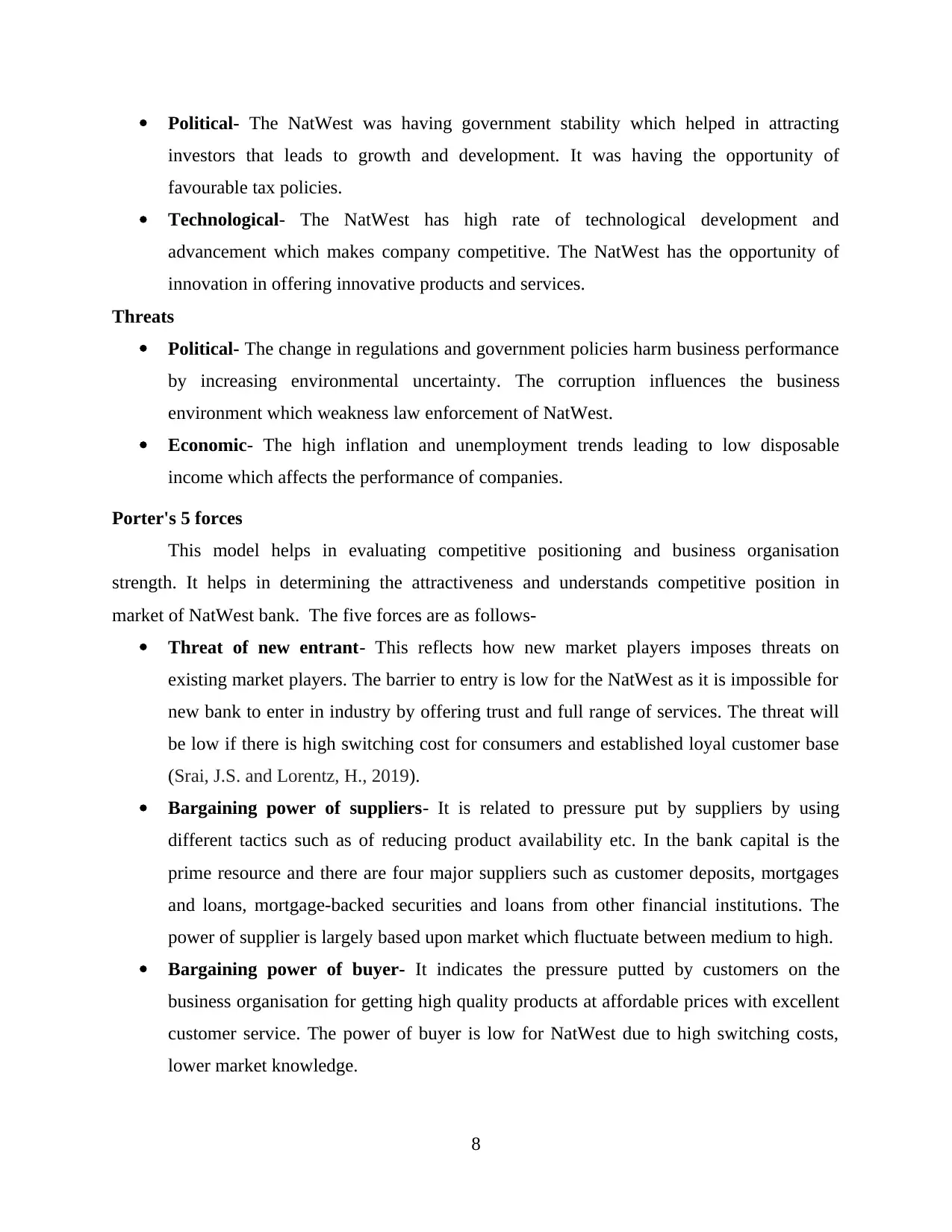
Political- The NatWest was having government stability which helped in attracting
investors that leads to growth and development. It was having the opportunity of
favourable tax policies.
Technological- The NatWest has high rate of technological development and
advancement which makes company competitive. The NatWest has the opportunity of
innovation in offering innovative products and services.
Threats
Political- The change in regulations and government policies harm business performance
by increasing environmental uncertainty. The corruption influences the business
environment which weakness law enforcement of NatWest.
Economic- The high inflation and unemployment trends leading to low disposable
income which affects the performance of companies.
Porter's 5 forces
This model helps in evaluating competitive positioning and business organisation
strength. It helps in determining the attractiveness and understands competitive position in
market of NatWest bank. The five forces are as follows-
Threat of new entrant- This reflects how new market players imposes threats on
existing market players. The barrier to entry is low for the NatWest as it is impossible for
new bank to enter in industry by offering trust and full range of services. The threat will
be low if there is high switching cost for consumers and established loyal customer base
(Srai, J.S. and Lorentz, H., 2019).
Bargaining power of suppliers- It is related to pressure put by suppliers by using
different tactics such as of reducing product availability etc. In the bank capital is the
prime resource and there are four major suppliers such as customer deposits, mortgages
and loans, mortgage-backed securities and loans from other financial institutions. The
power of supplier is largely based upon market which fluctuate between medium to high.
Bargaining power of buyer- It indicates the pressure putted by customers on the
business organisation for getting high quality products at affordable prices with excellent
customer service. The power of buyer is low for NatWest due to high switching costs,
lower market knowledge.
8
investors that leads to growth and development. It was having the opportunity of
favourable tax policies.
Technological- The NatWest has high rate of technological development and
advancement which makes company competitive. The NatWest has the opportunity of
innovation in offering innovative products and services.
Threats
Political- The change in regulations and government policies harm business performance
by increasing environmental uncertainty. The corruption influences the business
environment which weakness law enforcement of NatWest.
Economic- The high inflation and unemployment trends leading to low disposable
income which affects the performance of companies.
Porter's 5 forces
This model helps in evaluating competitive positioning and business organisation
strength. It helps in determining the attractiveness and understands competitive position in
market of NatWest bank. The five forces are as follows-
Threat of new entrant- This reflects how new market players imposes threats on
existing market players. The barrier to entry is low for the NatWest as it is impossible for
new bank to enter in industry by offering trust and full range of services. The threat will
be low if there is high switching cost for consumers and established loyal customer base
(Srai, J.S. and Lorentz, H., 2019).
Bargaining power of suppliers- It is related to pressure put by suppliers by using
different tactics such as of reducing product availability etc. In the bank capital is the
prime resource and there are four major suppliers such as customer deposits, mortgages
and loans, mortgage-backed securities and loans from other financial institutions. The
power of supplier is largely based upon market which fluctuate between medium to high.
Bargaining power of buyer- It indicates the pressure putted by customers on the
business organisation for getting high quality products at affordable prices with excellent
customer service. The power of buyer is low for NatWest due to high switching costs,
lower market knowledge.
8
Secure Best Marks with AI Grader
Need help grading? Try our AI Grader for instant feedback on your assignments.

Threat of substitutes- The availability of substitutes makes the competitive environment
challenging for NatWest. The high threat of substitutes shows that customers can make
use of alternatives. The power will be high for NatWest as there is substitutes availability
of payment method and loans. The cheap substitutes can be avail from another industry.
Competitive Rivalry- It shows the number of competitors that provides tough
competition to NatWest. The high rivalry puts strong pressure from the rival firms. The
rivalry for the NatWest can be low if there is limited number of players, industry is
growing at fast rate, exit barriers are low. The NatWest can face high rivalry if market
player are strategically diverse and targeting same market. There is high banking
competition (Tarla, D.N and et.al., 2017).
Porters generic strategies
This is used for determining the direction of organisation which involves four strategies.
Cost leadership strategy- This is related with low cost producer for the given level of
quality. The product is sell at average price for earning higher profits than rivals and
below the average industry price for gaining the market share. The NatWest can acquire
cost advantage by improving process efficiencies.
Differentiation strategy- This is related with the development of product or service
which offers unique attributes that is valued by customers and perceive better. The value
added by uniqueness of product allows firms for charging premium price in context to
NatWest.
Focus strategy- It focuses on narrow segment which attempts to achieve cost advantage
or differentiation. The NatWest pursuing focus strategy have lower volumes and less
bargaining power with suppliers.
Focus differentiation strategy- This is related to adding something extra as a result of
serving in the niche market for success. It adds the contribution for reducing costs and
increasing differentiation by understanding needs of customers in context of NatWest
bank.
9
challenging for NatWest. The high threat of substitutes shows that customers can make
use of alternatives. The power will be high for NatWest as there is substitutes availability
of payment method and loans. The cheap substitutes can be avail from another industry.
Competitive Rivalry- It shows the number of competitors that provides tough
competition to NatWest. The high rivalry puts strong pressure from the rival firms. The
rivalry for the NatWest can be low if there is limited number of players, industry is
growing at fast rate, exit barriers are low. The NatWest can face high rivalry if market
player are strategically diverse and targeting same market. There is high banking
competition (Tarla, D.N and et.al., 2017).
Porters generic strategies
This is used for determining the direction of organisation which involves four strategies.
Cost leadership strategy- This is related with low cost producer for the given level of
quality. The product is sell at average price for earning higher profits than rivals and
below the average industry price for gaining the market share. The NatWest can acquire
cost advantage by improving process efficiencies.
Differentiation strategy- This is related with the development of product or service
which offers unique attributes that is valued by customers and perceive better. The value
added by uniqueness of product allows firms for charging premium price in context to
NatWest.
Focus strategy- It focuses on narrow segment which attempts to achieve cost advantage
or differentiation. The NatWest pursuing focus strategy have lower volumes and less
bargaining power with suppliers.
Focus differentiation strategy- This is related to adding something extra as a result of
serving in the niche market for success. It adds the contribution for reducing costs and
increasing differentiation by understanding needs of customers in context of NatWest
bank.
9
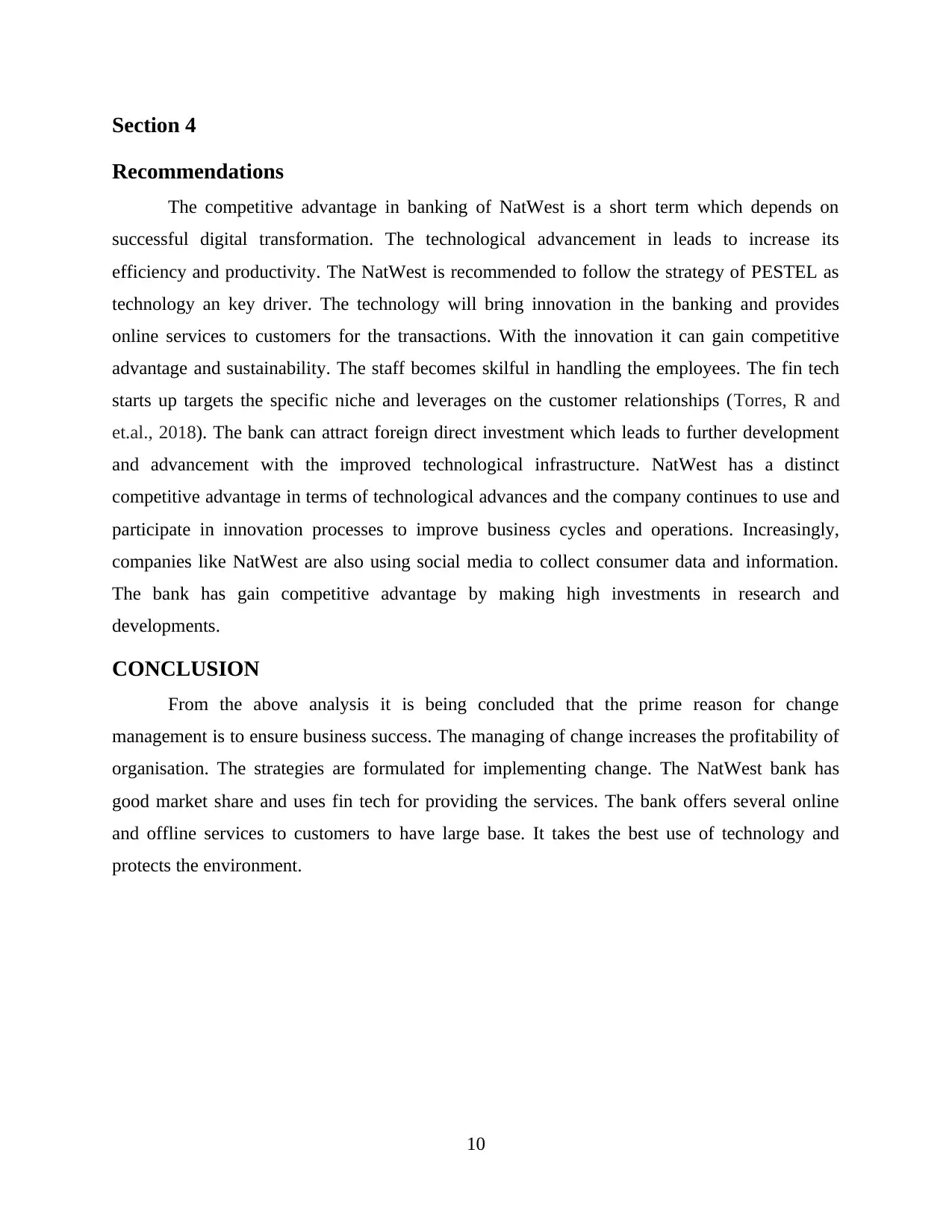
Section 4
Recommendations
The competitive advantage in banking of NatWest is a short term which depends on
successful digital transformation. The technological advancement in leads to increase its
efficiency and productivity. The NatWest is recommended to follow the strategy of PESTEL as
technology an key driver. The technology will bring innovation in the banking and provides
online services to customers for the transactions. With the innovation it can gain competitive
advantage and sustainability. The staff becomes skilful in handling the employees. The fin tech
starts up targets the specific niche and leverages on the customer relationships (Torres, R and
et.al., 2018). The bank can attract foreign direct investment which leads to further development
and advancement with the improved technological infrastructure. NatWest has a distinct
competitive advantage in terms of technological advances and the company continues to use and
participate in innovation processes to improve business cycles and operations. Increasingly,
companies like NatWest are also using social media to collect consumer data and information.
The bank has gain competitive advantage by making high investments in research and
developments.
CONCLUSION
From the above analysis it is being concluded that the prime reason for change
management is to ensure business success. The managing of change increases the profitability of
organisation. The strategies are formulated for implementing change. The NatWest bank has
good market share and uses fin tech for providing the services. The bank offers several online
and offline services to customers to have large base. It takes the best use of technology and
protects the environment.
10
Recommendations
The competitive advantage in banking of NatWest is a short term which depends on
successful digital transformation. The technological advancement in leads to increase its
efficiency and productivity. The NatWest is recommended to follow the strategy of PESTEL as
technology an key driver. The technology will bring innovation in the banking and provides
online services to customers for the transactions. With the innovation it can gain competitive
advantage and sustainability. The staff becomes skilful in handling the employees. The fin tech
starts up targets the specific niche and leverages on the customer relationships (Torres, R and
et.al., 2018). The bank can attract foreign direct investment which leads to further development
and advancement with the improved technological infrastructure. NatWest has a distinct
competitive advantage in terms of technological advances and the company continues to use and
participate in innovation processes to improve business cycles and operations. Increasingly,
companies like NatWest are also using social media to collect consumer data and information.
The bank has gain competitive advantage by making high investments in research and
developments.
CONCLUSION
From the above analysis it is being concluded that the prime reason for change
management is to ensure business success. The managing of change increases the profitability of
organisation. The strategies are formulated for implementing change. The NatWest bank has
good market share and uses fin tech for providing the services. The bank offers several online
and offline services to customers to have large base. It takes the best use of technology and
protects the environment.
10
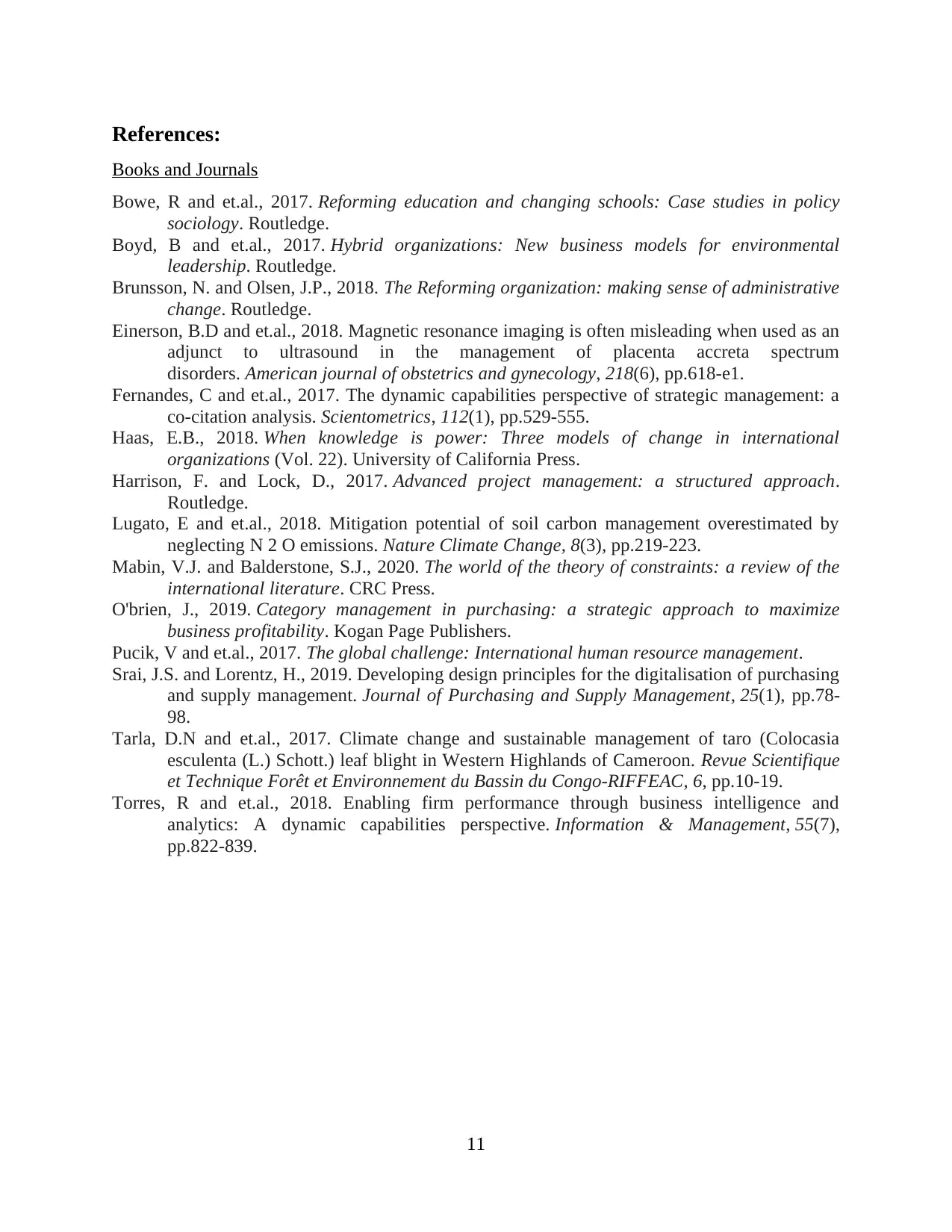
References:
Books and Journals
Bowe, R and et.al., 2017. Reforming education and changing schools: Case studies in policy
sociology. Routledge.
Boyd, B and et.al., 2017. Hybrid organizations: New business models for environmental
leadership. Routledge.
Brunsson, N. and Olsen, J.P., 2018. The Reforming organization: making sense of administrative
change. Routledge.
Einerson, B.D and et.al., 2018. Magnetic resonance imaging is often misleading when used as an
adjunct to ultrasound in the management of placenta accreta spectrum
disorders. American journal of obstetrics and gynecology, 218(6), pp.618-e1.
Fernandes, C and et.al., 2017. The dynamic capabilities perspective of strategic management: a
co-citation analysis. Scientometrics, 112(1), pp.529-555.
Haas, E.B., 2018. When knowledge is power: Three models of change in international
organizations (Vol. 22). University of California Press.
Harrison, F. and Lock, D., 2017. Advanced project management: a structured approach.
Routledge.
Lugato, E and et.al., 2018. Mitigation potential of soil carbon management overestimated by
neglecting N 2 O emissions. Nature Climate Change, 8(3), pp.219-223.
Mabin, V.J. and Balderstone, S.J., 2020. The world of the theory of constraints: a review of the
international literature. CRC Press.
O'brien, J., 2019. Category management in purchasing: a strategic approach to maximize
business profitability. Kogan Page Publishers.
Pucik, V and et.al., 2017. The global challenge: International human resource management.
Srai, J.S. and Lorentz, H., 2019. Developing design principles for the digitalisation of purchasing
and supply management. Journal of Purchasing and Supply Management, 25(1), pp.78-
98.
Tarla, D.N and et.al., 2017. Climate change and sustainable management of taro (Colocasia
esculenta (L.) Schott.) leaf blight in Western Highlands of Cameroon. Revue Scientifique
et Technique Forêt et Environnement du Bassin du Congo-RIFFEAC, 6, pp.10-19.
Torres, R and et.al., 2018. Enabling firm performance through business intelligence and
analytics: A dynamic capabilities perspective. Information & Management, 55(7),
pp.822-839.
11
Books and Journals
Bowe, R and et.al., 2017. Reforming education and changing schools: Case studies in policy
sociology. Routledge.
Boyd, B and et.al., 2017. Hybrid organizations: New business models for environmental
leadership. Routledge.
Brunsson, N. and Olsen, J.P., 2018. The Reforming organization: making sense of administrative
change. Routledge.
Einerson, B.D and et.al., 2018. Magnetic resonance imaging is often misleading when used as an
adjunct to ultrasound in the management of placenta accreta spectrum
disorders. American journal of obstetrics and gynecology, 218(6), pp.618-e1.
Fernandes, C and et.al., 2017. The dynamic capabilities perspective of strategic management: a
co-citation analysis. Scientometrics, 112(1), pp.529-555.
Haas, E.B., 2018. When knowledge is power: Three models of change in international
organizations (Vol. 22). University of California Press.
Harrison, F. and Lock, D., 2017. Advanced project management: a structured approach.
Routledge.
Lugato, E and et.al., 2018. Mitigation potential of soil carbon management overestimated by
neglecting N 2 O emissions. Nature Climate Change, 8(3), pp.219-223.
Mabin, V.J. and Balderstone, S.J., 2020. The world of the theory of constraints: a review of the
international literature. CRC Press.
O'brien, J., 2019. Category management in purchasing: a strategic approach to maximize
business profitability. Kogan Page Publishers.
Pucik, V and et.al., 2017. The global challenge: International human resource management.
Srai, J.S. and Lorentz, H., 2019. Developing design principles for the digitalisation of purchasing
and supply management. Journal of Purchasing and Supply Management, 25(1), pp.78-
98.
Tarla, D.N and et.al., 2017. Climate change and sustainable management of taro (Colocasia
esculenta (L.) Schott.) leaf blight in Western Highlands of Cameroon. Revue Scientifique
et Technique Forêt et Environnement du Bassin du Congo-RIFFEAC, 6, pp.10-19.
Torres, R and et.al., 2018. Enabling firm performance through business intelligence and
analytics: A dynamic capabilities perspective. Information & Management, 55(7),
pp.822-839.
11
1 out of 13
Related Documents
Your All-in-One AI-Powered Toolkit for Academic Success.
+13062052269
info@desklib.com
Available 24*7 on WhatsApp / Email
![[object Object]](/_next/static/media/star-bottom.7253800d.svg)
Unlock your academic potential
© 2024 | Zucol Services PVT LTD | All rights reserved.





